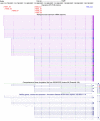Alternative promoters and splicing create multiple functionally distinct isoforms of oestrogen receptor alpha in breast cancer and healthy tissues
- PMID: 37676103
- PMCID: PMC10557849
- DOI: 10.1002/cam4.6508
Alternative promoters and splicing create multiple functionally distinct isoforms of oestrogen receptor alpha in breast cancer and healthy tissues
Abstract
Background: Oestrogen receptor alpha (ER) is involved in cell growth and proliferation and functions as a transcription factor, a transcriptional coregulator, and in cytoplasmic signalling. It affects, for example, bone, endometrium, ovaries and mammary epithelium. It is a key biomarker in clinical management of breast cancer, where it is used as a prognostic and treatment-predictive factor, and a therapeutical target. Several ER isoforms have been described, but transcript annotation in public databases is incomplete and inconsistent, and functional differences are not well understood.
Methods: We have analysed short- and long-read RNA sequencing data from breast tumours, breast cancer cell lines, and normal tissues to create a comprehensive annotation of ER transcripts and combined it with experimental studies of full-length protein and six alternative isoforms.
Results: The isoforms have varying transcription factor activity, subcellular localisation, and response to the ER-targeting drugs tamoxifen and fulvestrant. Antibodies differ in ability to detect alternative isoforms, which raises concerns for the interpretation of ER-status in routine pathology.
Conclusions: Future work should investigate the effects of alternative isoforms on patient survival and therapy response. An accurate annotation of ER isoforms will aid in interpretation of clinical data and inform functional studies to improve our understanding of the ER in health and disease.
Keywords: alternative splicing; breast cancer; isoforms; oestrogen receptor.
© 2023 The Authors. Cancer Medicine published by John Wiley & Sons Ltd.
Conflict of interest statement
The authors do not declare any conflicts of interest.
Figures





Similar articles
-
Antagonism of oestrogen action in human breast and endometrial cells in vitro: potential novel antitumour agents.Cancer Chemother Pharmacol. 2001 May;47(5):437-43. doi: 10.1007/s002800000259. Cancer Chemother Pharmacol. 2001. PMID: 11391860
-
Expression and splicing of the unfolded protein response gene XBP-1 are significantly associated with clinical outcome of endocrine-treated breast cancer.Int J Cancer. 2008 Jul 1;123(1):85-8. doi: 10.1002/ijc.23479. Int J Cancer. 2008. PMID: 18386815
-
Oestrogen receptors pathways to oestrogen responsive elements: the transactivation function-1 acts as the keystone of oestrogen receptor (ER)beta-mediated transcriptional repression of ERalpha.J Steroid Biochem Mol Biol. 2007 May;104(3-5):110-22. doi: 10.1016/j.jsbmb.2007.03.002. Epub 2007 Mar 12. J Steroid Biochem Mol Biol. 2007. PMID: 17478088
-
Pure oestrogen antagonists for the treatment of advanced breast cancer.Endocr Relat Cancer. 2006 Sep;13(3):689-706. doi: 10.1677/erc.1.00846. Endocr Relat Cancer. 2006. PMID: 16954425 Review.
-
Epidermal growth factor receptor/HER2/insulin-like growth factor receptor signalling and oestrogen receptor activity in clinical breast cancer.Endocr Relat Cancer. 2005 Jul;12 Suppl 1:S99-S111. doi: 10.1677/erc.1.01005. Endocr Relat Cancer. 2005. PMID: 16113104 Review.
Cited by
-
Dynamic methylation and expression of alternative promoters for oestrogen receptor alpha in cell line models of fulvestrant resistance.Mol Oncol. 2025 Jan;19(1):204-224. doi: 10.1002/1878-0261.13713. Epub 2024 Aug 6. Mol Oncol. 2025. PMID: 39108022 Free PMC article.
References
-
- Uhlen M, Fagerberg L, Hallstrom BM, et al. Proteomics. Tissue‐based map of the human proteome. Science. 2015;347:1260419. - PubMed
LinkOut - more resources
Full Text Sources
Molecular Biology Databases

